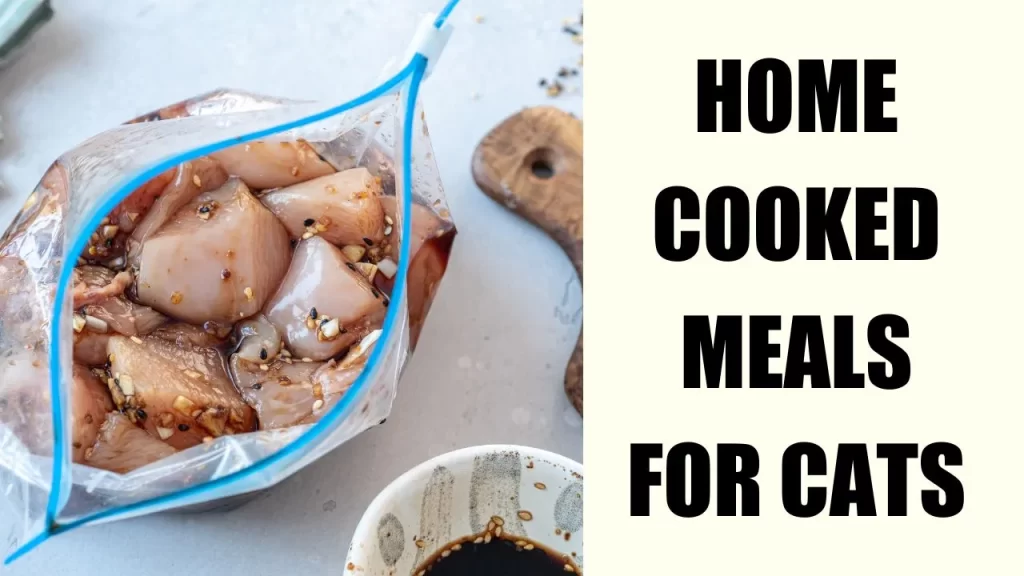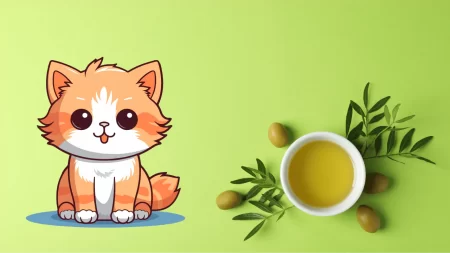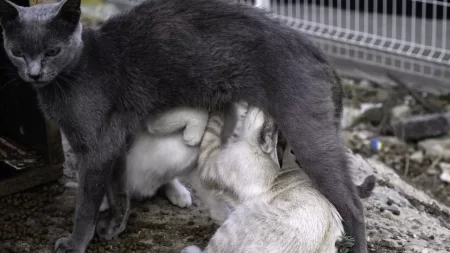If you love your cat and want to provide them with the best nutrition possible, you might consider making your own cat food at home.
Home cooked meals for cats can have many benefits, such as improved nutrition, catering to specific needs, control over ingredients, and quality time with your cat.
However, making homemade cat food is not as simple as throwing some meat and veggies in a bowl.
You need to understand your cat’s nutritional needs, follow safety precautions, balance cooked and raw food, and use supplements and additives as needed.
In this guide, we will explain how to make homemade cat food that is healthy, delicious, and suitable for your cat.
Benefits of Home Cooked Meals for Cats
There are many reasons why you might want to make your own cat food at home. Some of the benefits include:
- Improved Nutrition: Cats are obligate carnivores, which means they need animal protein and fat to thrive. Commercial cat food may contain fillers, by-products, artificial colors, flavors, preservatives, and other additives that can compromise your cat’s health. Homemade cat food allows you to choose high-quality ingredients that are fresh, natural, and suitable for your cat’s needs.
- Catering to Specific Needs: Some cats may have allergies, sensitivities, or medical conditions that require a special diet. For example, cats with kidney disease may need a low-phosphorus diet, while cats with diabetes may need a low-carbohydrate diet. Homemade cat food gives you the flexibility to adjust the ingredients and portions according to your cat’s individual needs.
- Control Over Ingredients: When you make your own cat food, you know exactly what goes into it. You can avoid ingredients that your cat dislikes or that may cause adverse reactions. You can also source your ingredients from organic, free-range, or sustainable sources if you prefer.
- Quality Time with Your Cat: Making homemade cat food can be a fun and rewarding activity that you can share with your cat. You can involve your cat in the process by letting them sniff or taste the ingredients, or by feeding them some treats while you cook. You can also bond with your cat by serving them their homemade meal and watching them enjoy it.
Understanding Your Cat’s Nutritional Needs
Before you start making homemade cat food, you need to understand what nutrients your cat needs and how much of them. Cats require a balanced diet that provides:
Essential Nutrients for Cats
These include protein, fat, water, vitamins, minerals, amino acids (such as taurine), and fatty acids (such as omega-3 and omega-6). These nutrients are vital for your cat’s growth, development, maintenance, and health.
Nutritional Requirements for Different Life Stages
Kittens, adult cats, senior cats, pregnant cats, and lactating cats have different nutritional requirements based on their age and physiological state. For example, kittens need more protein and calories than adult cats, while senior cats need less phosphorus and sodium than younger cats. You need to adjust your homemade cat food accordingly to meet your cat’s life stage needs.
Common Foods to Avoid
Some foods that are safe or beneficial for humans may be harmful or toxic for cats. These include chocolate, grapes, raisins, onions, garlic, chives, leeks, dairy products (except small amounts of cheese or yogurt), raw eggs (due to salmonella risk), raw fish (due to thiamine deficiency risk), bones (due to choking or splintering risk), and alcohol. You should also avoid foods that are high in salt, sugar, fat, or spices.
The Dangers of Commercial Pet Food
Commercial pet food may seem convenient and economical, but it may not be the best option for your cat’s health. As mentioned earlier, commercial pet food may contain low-quality ingredients that are processed or rendered from animal parts that are not fit for human consumption.
These ingredients may be contaminated with bacteria, parasites, hormones, antibiotics, or heavy metals.
Commercial pet food may also lack essential nutrients or contain excessive amounts of carbohydrates or additives that can cause obesity, diabetes, urinary tract problems, allergies, or other health issues.
How to Make Homemade Cat Food?
Now that you know what nutrients your cat needs and what foods to avoid, you can start making homemade cat food by following these steps:
1. Safety Precautions
Before you handle any raw meat or poultry, wash your hands thoroughly with soap and water. Use separate cutting boards, knives, and utensils for raw meat and other ingredients. Wash all equipment and surfaces with hot water and soap after use. Keep raw meat in the refrigerator or freezer until it’s needed. Do not feed your cat any spoiled or expired food.
2. Balancing Cooked and Raw Food
Some people prefer to feed their cats a raw diet, while others prefer to cook their food. There are pros and cons to both methods and ultimately it depends on your personal preference and your cat’s acceptance.
Raw food may provide more enzymes, antioxidants, and natural moisture than cooked food, but it may also carry a higher risk of bacterial contamination or parasitic infection.
Cooked food may be safer and easier to digest than raw food, but it may also lose some nutrients or taurine during the cooking process. If you choose to cook your food, use gentle methods such as boiling, steaming, or baking to preserve as many nutrients as possible.
Do not add any salt, oil, or seasonings to the food. If you choose to feed raw food, make sure it is fresh and from a reputable source.
Freeze the meat for at least 24 hours before feeding to kill any parasites or pathogens. You can also feed a combination of cooked and raw food to provide variety and balance for your cat.
3. Tips for Meal Prepping and Storage
Making homemade cat food can be time-consuming and labor-intensive, so you may want to prepare large batches and store them for later use.
You can divide the food into individual portions and freeze them in ziplock bags or plastic containers. Label each portion with the date and ingredients for easy identification.
You can thaw the frozen portions in the refrigerator overnight or in the microwave for a few minutes before feeding.
Do not refreeze thawed portions or keep them in the refrigerator for more than three days. You can also refrigerate unused portions of fresh food for up to two days. Always check the food for any signs of spoilage such as mold, discoloration, or foul odor before feeding.
4. Recipe Ideas for Different Dietary Needs
There are many recipes online that you can follow or adapt to make homemade cat food for different dietary needs. Here are some examples:
Basic Chicken Recipe
For a basic chicken recipe, you will need 3 pounds of chicken thighs with bone, 7 ounces of chicken liver, 14 ounces of chicken heart, 8 ounces of water, 4 egg yolks, 2000 mg of taurine supplement, 200 mg of vitamin B complex supplement, 2 teaspoons of low-sodium salt, and 4 teaspoons of bone meal supplement.
Remove the skin from the chicken thighs and cut off any excess fat. Cut the meat into small pieces and grind them with the bones in a meat grinder or a food processor. Grind the liver and heart separately and mix them with the ground meat mixture.
Add the water, egg yolks, taurine supplement, vitamin B complex supplement, low-sodium salt, and bone meal supplement, and mix well until everything is evenly distributed. This recipe yields approximately 10 cups of food.
Salmon Recipe
For a salmon recipe, you will need 1 pound of salmon fillet with skin on, half a cup of cooked brown rice, half a cup of cooked oatmeal, half a cup of cooked green beans (chopped), half a cup of cooked carrots (chopped), half a cup of cooked spinach (chopped), one egg (beaten), one tablespoon of olive oil, one teaspoon of dried parsley flakes.
Cut the salmon into small pieces and remove any bones. Place the salmon pieces in a baking dish and drizzle with olive oil and parsley flakes. Bake in a preheated oven at 375°F for about 15 minutes or until cooked through.
Allow the dish to cool a bit before gently separating the cooked pieces with a fork. In a large bowl, combine the cooked rice, oatmeal, green beans, carrots, spinach, egg, and flaked salmon and mix well until everything is well combined. This recipe makes about six cups of food.
Beef Recipe
For a beef recipe, you will need 2 pounds of lean ground beef, half a cup of grated cheddar cheese, half a cup of cottage cheese, one-fourth cup of brewer’s yeast, one-fourth cup of wheat germ, one tablespoon of vegetable oil, one teaspoon of dried parsley flakes. In a large skillet, cook the ground beef over medium-high heat, breaking it up with a spatula, until browned and cooked through.
Drain the excess fat and transfer the beef to a large bowl. Add the cheese, cottage cheese, brewer’s yeast, wheat germ, oil, and parsley flakes and mix well until everything is well combined. This recipe makes about eight cups of food.
Supplements and Additives
Even if you use high-quality ingredients and follow a balanced recipe, you may still need to add some supplements and additives to your homemade cat food to ensure it meets your cat’s nutritional needs. Some of the supplements and additives you may need include:
Taurine
Taurine is an essential amino acid for cats that supports their heart, eye, brain, and immune health. Cats cannot synthesize enough taurine from other amino acids, so they need to get it from their diet. Taurine is found in animal tissues, especially in the heart and liver, but it can be destroyed by heat or oxidation. Therefore, you may need to add a taurine supplement to your homemade cat food, especially if you cook it or use low-taurine ingredients. Cats require a daily intake of taurine ranging from 250 to 500 mg.
Vitamin B Complex
Vitamin B complex is a group of water-soluble vitamins that play important roles in your cat’s metabolism, energy production, nerve function, blood cell formation, and skin health. Cats can synthesize some of these vitamins from their food, but they may need extra supplementation of others, such as vitamin B12, niacin, and folic acid. Vitamin B complex supplements are available in liquid or powder form that you can add to your homemade cat food.
Calcium
Calcium is a mineral that is essential for your cat’s bone health, muscle contraction, nerve transmission, blood clotting, and enzyme activity. Cats need about 200 mg of calcium per kg of body weight per day. Calcium can be obtained from animal bones or bone meal supplements that are finely ground and sterilized. You can also use finely crushed eggshells or calcium lactate supplements as alternative sources of calcium.
Fish Oil
Fish oil is a source of omega-3 fatty acids that have anti-inflammatory and antioxidant properties. Omega-3 fatty acids can benefit your cat’s skin, coat, joints, kidneys, heart, and brain health. Fish oil can be added to your homemade cat food in liquid or capsule form. You can also use sardines or salmon as natural sources of omega-3 fatty acids.
Low-Sodium Salt
Low-sodium salt is a type of salt that contains less sodium and more potassium than regular salt. Sodium and potassium are electrolytes that help regulate your cat’s fluid balance, blood pressure, nerve function, and muscle activity. Low-sodium salt can help your cat get adequate levels of iodine in their diet, which is important for their thyroid health. You can add a small amount of low-sodium salt to your homemade cat food or use iodized salt as an alternative.
Making homemade cat food can be a rewarding way to show your love and care for your cat. However, it requires careful planning, preparation, and supplementation to ensure it is safe, healthy, and balanced for your cat’s needs. Always consult your veterinarian or a veterinary nutritionist before switching your cat to a homemade diet or making any changes to their current diet.







